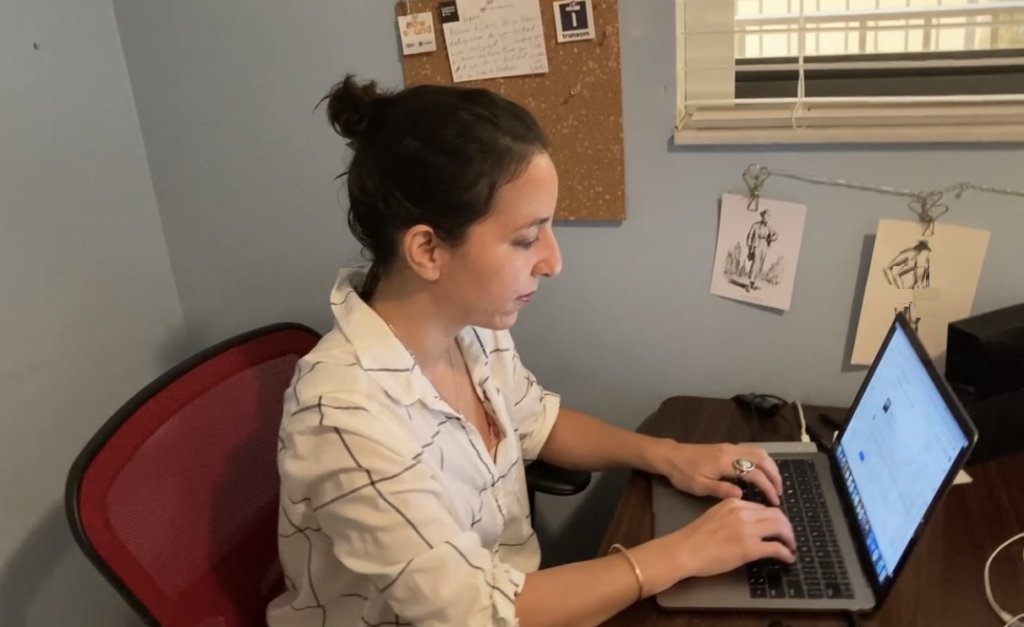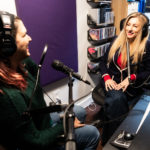Delegate, Communicate and Trust the Process
I came to Feet in 2 Worlds (Fi2W) as an Editing Fellow excited to hone my editing skills. While I’ve had opportunities in the past to offer feedback and editorial recommendations while working as a producer, I was looking forward to having a role where I could take the lead as an editor and focus on helping reporters, writers and producers make their pieces better—rather than producing stories myself. Having heard from past colleagues that working as an editor helped them become better producers, and vice versa, I was hoping this fellowship would also make me a stronger storyteller and better collaborator overall .
As my Fi2W fellowship comes to a close, I’m grateful to say it checked all the boxes and then some. As a fellow, I was able to wear all the hats an editor wears to see projects through, including sounding board, supervisor, teacher, manager, even cheerleader and, occasionally, writing coach. I learned so much from Fi2W’s editorial team, not only about story editing, but also about creating partnerships, and working with reporters of all backgrounds and experiences. Looking back though, the most significant lesson for me has been learning to let go, and to trust the editing process—which turns out to be key to taking a story from the seed of an idea to a fully-produced piece.
As an editor, I often had two thoughts in my mind at the same time. One, a reminder to myself: let the reporter tell the story. And two, a question: what does the story need?
The funny thing is, I didn’t realize this was something I needed to work on. In a certain way, trying to control things as much as possible and preparing for the worst-case scenario is what makes me a strong producer. I have backup plans for my backup plans. I give myself soft “pretend” deadlines so I don’t miss an actual deadline. I arrive on site for an assignment at least 20 minutes early so I’m on time, rain or shine or traffic. I am the queen of the follow-up and the triple-check. I trust, because I verify. Through this editing fellowship, I realized that wanting to have full control and certainty, is often what keeps a story from being as good as it could be.
My main assignment as a Fi2W fellow was to curate a series of audio and digital/written pieces for our online magazine series, Immigrants in a Divided Country, which explores our divided political landscape from the perspective of immigrants. At the start of the fellowship I had to sort through submissions to our call for pitches, and also assign stories Fi2W wanted covered to reporters we hoped to work with. Right away there were abundant opportunities to practice acceptance and letting go of control. While we received several strong submissions, there were a couple of pitches and story ideas I was really excited about originally that ended up not working out. In some cases, it took several conversations with a potential partner or reporter, various pitch revisions, or even doing some reporting or writing to figure out that a story ultimately did not fit our project. Rationally I understood we had to let them go to make room for other things, but part of me still wonders about some of them: “If only…”
On the flip side, there were several story ideas we received that would have never occurred to me personally if I’d been pitching us. Our series was about politics, but here was a proposal for a story that aimed to explore the role of art in shaping public discourse around a national controversy. And here was a personal audio essay about the impact of politics on intergenerational and intercultural divides within one family. Initially, some ideas seemed only tangentially related to our project, but after talking them through with Fi2W’s editorial team and noticing the conversations they sparked and the intriguing questions they raised, it was clear the pieces would add a different dimension to our series—one none of us had imagined originally, but that truly belonged there. This skill-seeing something for what it could be, recognizing possibilities and potential—is one I had the chance to practice over and over with each draft I read and audio piece listened to.
We assigned and produced eight stories in total. From the start, working with our reporters brought up challenging questions to nibble on: What’s the best way to give rigorous feedback that is honest and useful, but also kind? How to offer clear editorial guidance that also makes room for a reporter’s ideas and voice to come through? Where does a writer’s creative license end and where does my responsibility to the audience as editor begin? The process of answering them involved experimentation and trial and error. I was used to operating from the other side, so the back-and-forth dance between editor and reporter from this vantage point was eye-opening.
When I look back at our finished stories, I notice that some of my favorite parts within each of them are places where the reporter and I had to work something out. In these moments of editorial tension, we didn’t immediately agree on how a problem should be solved or what the right answer was. We would talk this through, bring up our different concerns, brainstorm ideas, but ultimately, it was up to the reporter to go back to the draft (or a source, or a scene), use their judgment, creativity and resourcefulness to address whatever the issue was. My role was to wait for the next draft, and trust that what I had tried to communicate with my feedback, landed.
As an editor, I often had two thoughts in my mind at the same time. One, a reminder to myself: let the reporter tell the story. And two, a question: what does the story need? These are not necessarily contradictory thoughts (something I often had to remind myself). It is actually possible to identify what’s missing, and then to not fix it, and let someone else do it. Not only is it feasible, it’s expected. That’s the editor’s job.
As a producer, I dislike being micromanaged. As an editor, I did not want to operate that way, so, I tried to focus on different questions: what is already working? When the first draft of a feature story came in reading more like a news piece, what was working there? The writer had a tendency to stick strictly to the facts and avoid any kind of extrapolation. It was not what I had envisioned the piece to be, but it is evidence of their diligent reporting—definitely something we could build on and which ultimately made for a deeply reported piece.
Another helpful question for me to keep in mind was: what is the writer/producer trying to do? When one piece came in with unusual sound design elements, I thought “this is a mistake.” Speaking with the producer however, I learned that these were very deliberate decisions based on his taste. His choices were nothing like I’d ever heard or worked with in the past, and not necessarily ones I would make. But—now that I understood what he was trying to do—they did not not work. Instead of asking him to remove them or label them as distracting, I was able to see the potential and help him run with it. I made some specific suggestions for how to keep most of the sonic elements in a way that achieved what he was trying to do, while also aligned with the overall style of our series. The final piece showcases the humor and ingenuity of this producer and inspired me to consider how sound can connect with an audience in unexpected ways.
In some instances, letting go of control and being open to a different way of doing things was not about a reporter’s story or aesthetic preferences, but about their workstyle. In an effort to keep us all organized and on schedule, I created production spreadsheets and timelines for each of our stories. Some reporters never missed a deadline and stayed in constant communication. For others, deadlines came and went and, despite my emails, texts and phone calls checking in, we had a hard time reconnecting at various stages of the reporting and writing process. Then, when I least expected it, an impressive draft would show up in my inbox. Knowing the reason for the delays gave me the chance to troubleshoot and offer support: a source can’t be reached, a fact-checker needs more time, a reporter needs a sounding board to make a storyline make sense. But sometimes delays just happened and I never fully understood why. Still, the reporters always came through. My conclusion? Different people work at a different pace. Sometimes timelines are aspirational. We can move the deadlines.
There were countless moments during my fellowship where I had to adapt to the changing needs of a story or my team. Or where I had to make decisions without having all the answers, or trust my editorial judgment while also remaining open to trying things differently. I deeply appreciate the opportunity to practice this over and over, and for the support of the Fi2W team along the way. Truth be told though, I was surprised at how much of a stretch this was for me. But ultimately I’m really proud of how much stronger, more creative and ambitious our stories turned out to be as a result. You don’t need to control everything, Virginia. The process works.
One of my favorite questions to ask as an interviewer is: “What did you think [blank] would be like, before you ever did [blank]?” I thought my editing fellowship would be about exploring story structure and big-picture questions—and it was. What I did not expect is that it would also be a personal journey that held up a mirror to myself: “This is you, the control freak.”
Feet in 2 Worlds is supported by the John D. and Catherine T. MacArthur Foundation, The Ford Foundation, the David and Katherine Moore Family Foundation, the Ralph E. Ogden Foundation, the Fernandez Pave the Way Foundation, an anonymous donor and readers like you.




